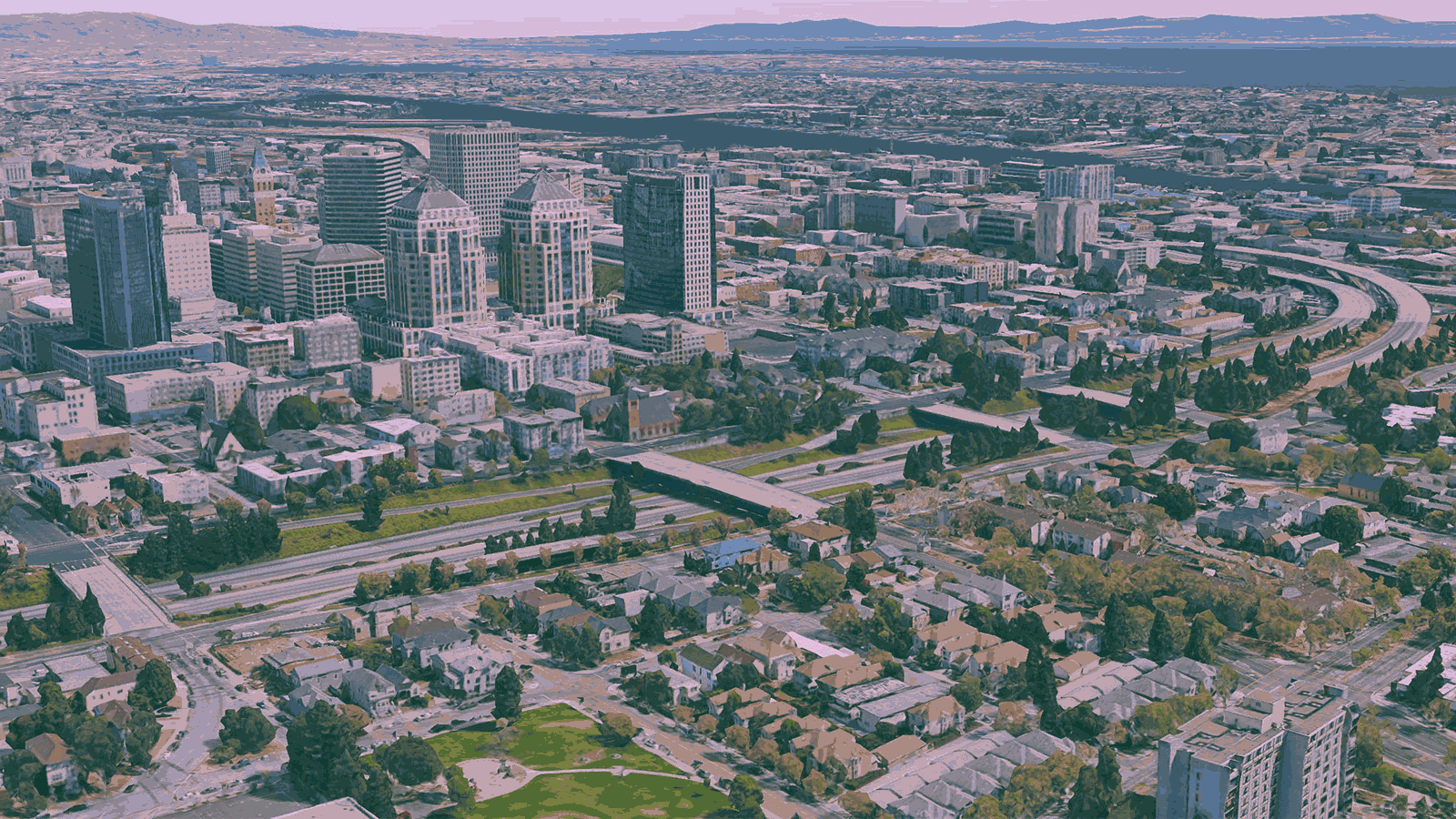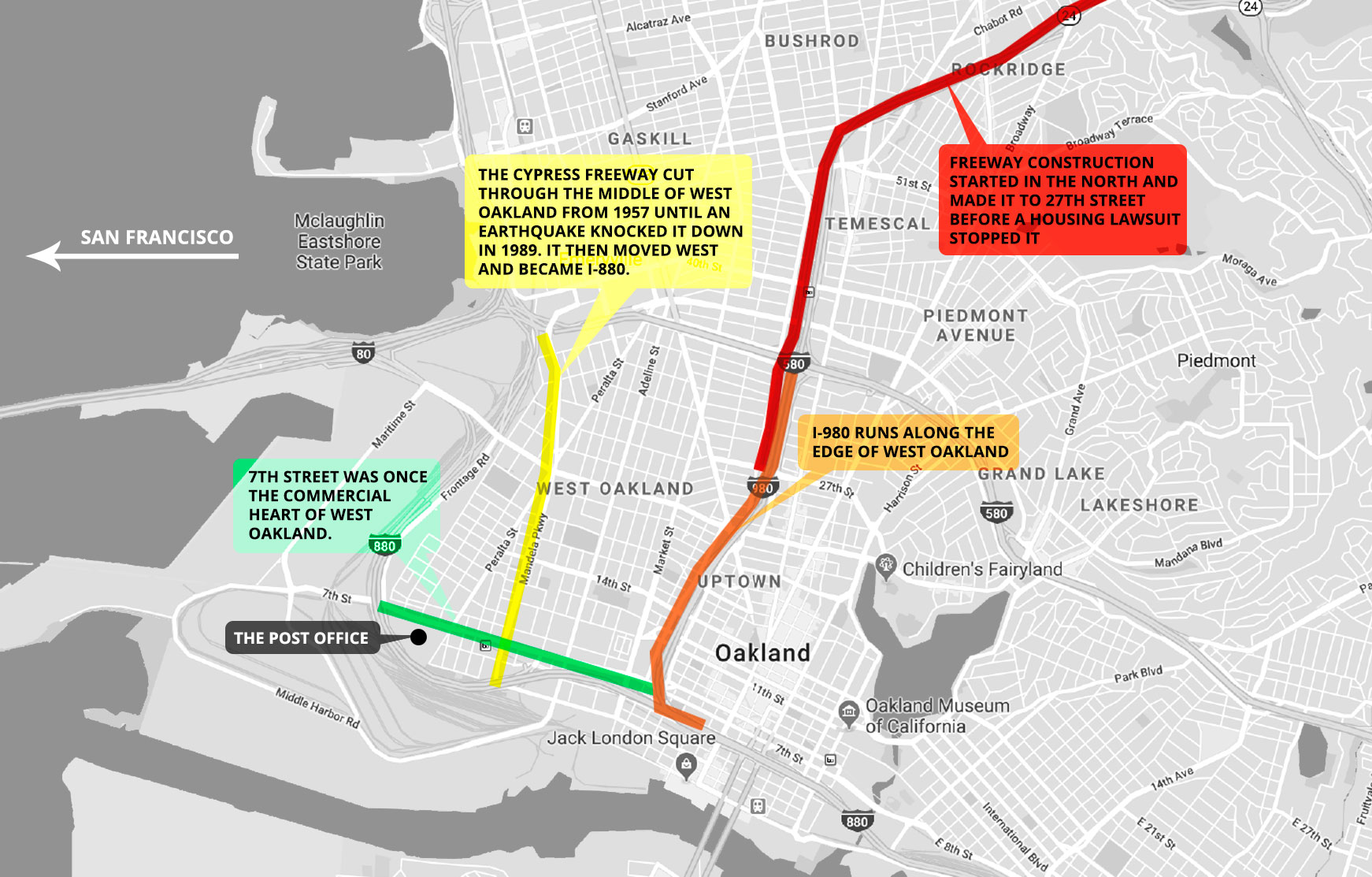When a government official takes a reporter out to see some concrete colossus, it’s usually to show it off. Not this time. On a recent spring morning, Matt Nichols, transportation director of Oakland, California, gazed down through a chain-link fence walling off a sidewalk overpass from the massive sunken freeway below — I-980, which runs between downtown Oakland and the historically black neighborhood of West Oakland.
Five lanes of traffic howled beneath his feet at 70 miles per hour. Throughout the 1970s, Nichols’ predecessors had argued that Oakland needed to build this freeway to thrive. But when Nichols looks at it, he doesn’t see a triumph of infrastructure.
“What I see is desolation,” he said.
Nichols pointed toward a line of houses with a view of an onramp. Noise and pollution spreads into the surroundings, he said. “You can feel the impoverishment of what a freeway does to a community.”
Oakland’s mayor, Libby Schaaf, thinks the land has a higher use: I-980, she has said, “remains a scar on our urban fabric. In its place we want livable infrastructure that creates local economic opportunity, reconnects neighborhoods, and connects the region.” So the city government has made the freeway’s removal a part of its plan for a growing downtown Oakland.
The reasons to build inner-city highways seemed obvious in the 1950s, the golden age of the automobile. They allowed thousands of cars to flow through big cities without slowing down and clogging up streets. Like TV dinners, Tang, and dishwashers, they made things convenient.
Today, however, city politicians and community organizers have started talking about reasons to remove them. They pepper nearby neighborhoods with soot; they break up cities, making it harder to walk across town; they take up acres of space that could go to parks, houses, and public transit.
Then there’s the crisis of climate change. Transportation, the world’s biggest source of greenhouse gases, will require an overhaul to become carbon free. That means rethinking and rebuilding every aspect of getting around, from the internal combustion engine to the roadways on which we move. Highways, after all, were made to serve machines forged and fueled by hydrocarbons.
The Congress for the New Urbanism, a group of planners, architects, and activists, has been campaigning to remove these relics of an unenlightened past. The organization recently released a report on the top 10 “Freeways Without Futures.” It includes highways that carve up New Orleans; Austin, Texas; Portland, Oregon; as well as I-980 in Oakland.
“Freeway construction was a disaster for city neighborhoods in the 20th Century,” the report said. “Many neighborhoods were divided in two — their main streets demolished and businesses closed, disproportionately in minority communities.”
Progressives like Chris Sensenig now see freeway removal as a once-in-a-generation opportunity to redress the wrongs of the past and make cities radically greener. For nearly a decade, the urban designer has been thinking seriously about what Oakland would look like without I-980. And the more he thought about it — the more he collected old maps and pictures of the landscape before the highway — the more excited he became. He joined up with other like-minded people to form ConnectOakland, a small organization dedicated to envisioning a neighborhood free of I-980.
“The key thing is that this is public land,” Sensenig said. “Public land is for the public good. We should be seeking to maximize the public good, not just accepting whatever happens to already be there.”
By removing just the section of freeway next to downtown Oakland, the city would get 13 empty city blocks. Parks, leafy boulevards, and affordable housing could spread down that corridor. Trains could whisk people underneath: This section of I-980 runs through a massive trench, some 20 feet below the rest of the city streets, which could serve as a readymade tunnel for the second much-needed subway crossing planned between Oakland and San Francisco. And once the ConnectOakland team started thinking about rail, they realized there would be plenty of space not just for the train system, BART, but also for a commuter line between San Francisco and San Jose, and for Amtrak, and maybe even for high-speed rail. There could be enough room for an entire underground rail yard to store trains and shuffle them between tracks.
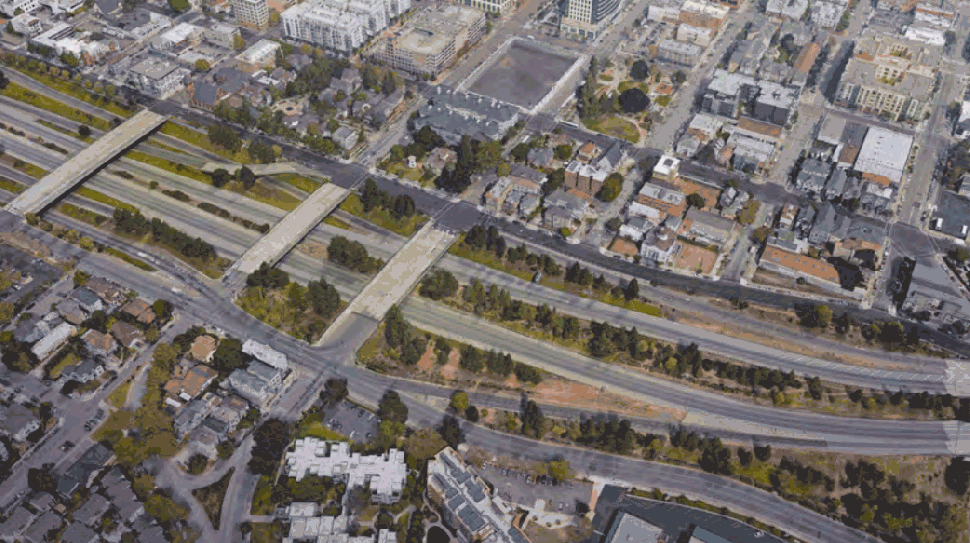
Downtown Oakland Preliminary Draft Plan
To hear Sensenig wax on, scrapping I-980 seems like a no-brainer. But the historical argument for getting rid of it assumes the freeway is a legacy of mid-century attempts to build barriers around white middle-class neighborhoods, or as a wrecking ball to replace “urban blight.” That’s true of many major freeways, but the story of I-980 isn’t so clear cut. By the time the state of California finally finished building it in 1985, the residents of West Oakland had come on board. At that point, according to Roger Clay, Jr., a lawyer who sued the state on behalf of residents whose homes were destroyed by the project, “The community wanted this freeway.”
Today, some of those same residents find themselves wary of another major public works project in their backyard. And that means activists’ best intentions are colliding with a community that might prefer to be left alone.
When I floated Sensenig’s vision to people who had lived in West Oakland when the freeway was built, their reactions ranged from skepticism to outright scorn. To comprehend why old timers from this historically black neighborhood are so dubious, you have to understand two seemingly conflicting things: that West Oakland has been repeatedly screwed over by infrastructure projects and that the history of I-980 freeway deviates from that pattern.
In the 1940s, officials made plans to run the freeway along the edge of West Oakland. In his book, The Color of Law: A Forgotten History of How Our Government Segregated America, the historian Richard Rothstein lays bare the reasoning behind many urban freeways of that era: They were a tool to maintain segregation.
It starts with the Federal Housing Administration, created in 1934, which insured mortgages covering 80 percent of the cost of a house — but only in all-white neighborhoods. “The FHA judged that properties would probably be too risky for insurance if they were in racially mixed neighborhoods or even in white neighborhoods near black ones that might possibly integrate in the future,” Rothstein wrote. An FHA underwriting manual notes that highways were “effective in protecting a neighborhood and the locations within it from … inharmonious racial groups.”
Miami, Los Angeles, and other big cities routed freeways to cordon off, or pave over, minority neighborhoods, Rothstein wrote. The double-decker Cypress Freeway plowed through the middle of West Oakland in the 1950s, and another freeway was planned that would mark a firm line between white Oakland, and black West Oakland — I-980.
“Terrible” Tom Bowden, a blues singer who has lived on the same street in West Oakland since 1941, said that his neighborhood was bustling with black-owned businesses before bulldozers took it apart.
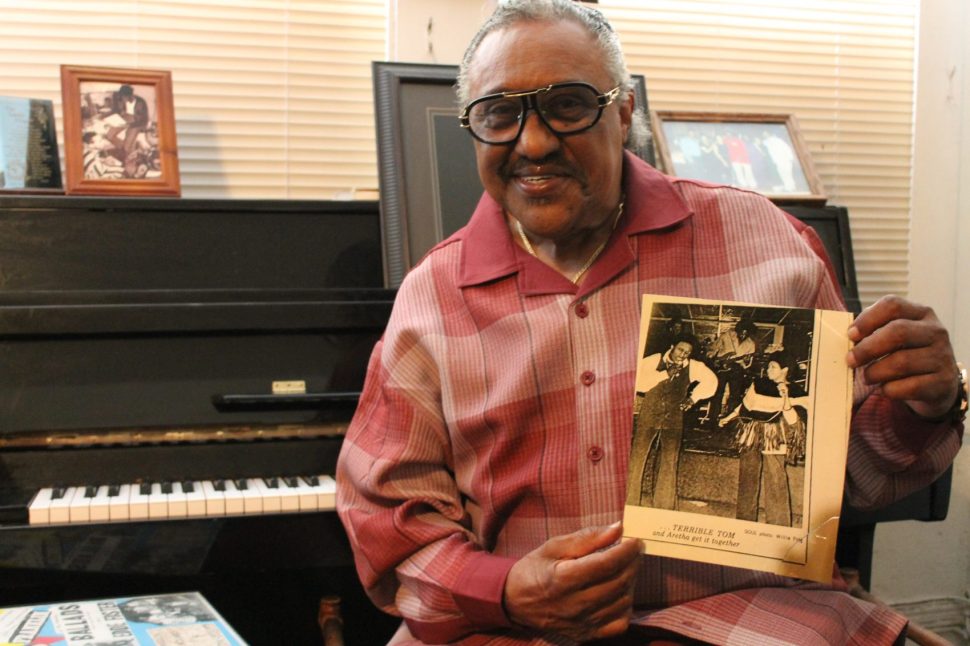
“Terrible” Tom Bowden with a photo of him singing with Aretha Franklin. Photo by Nathanael Johnson
“We had a Harlem of the West, and it stayed open 24 hours a day, starting with Slim Jenkins — the nightclub where I used to shine shoes for a nickel. They had clubs, back to back, the Kit Kat club, the Rex Pool Hall …” Bowden looked up, searching his memory then retrieved an envelope crammed with the names of businesses lost to time. There were barber shops, a record store, two movie theaters, a recording studio, a bank, a bowling alley, hotels, a drug store, and clothing shops. All of them, save a couple restaurants, are gone.
When I asked Bowden what happened, he scoffed: “What happened? You know what happened. Poli-tricks.”
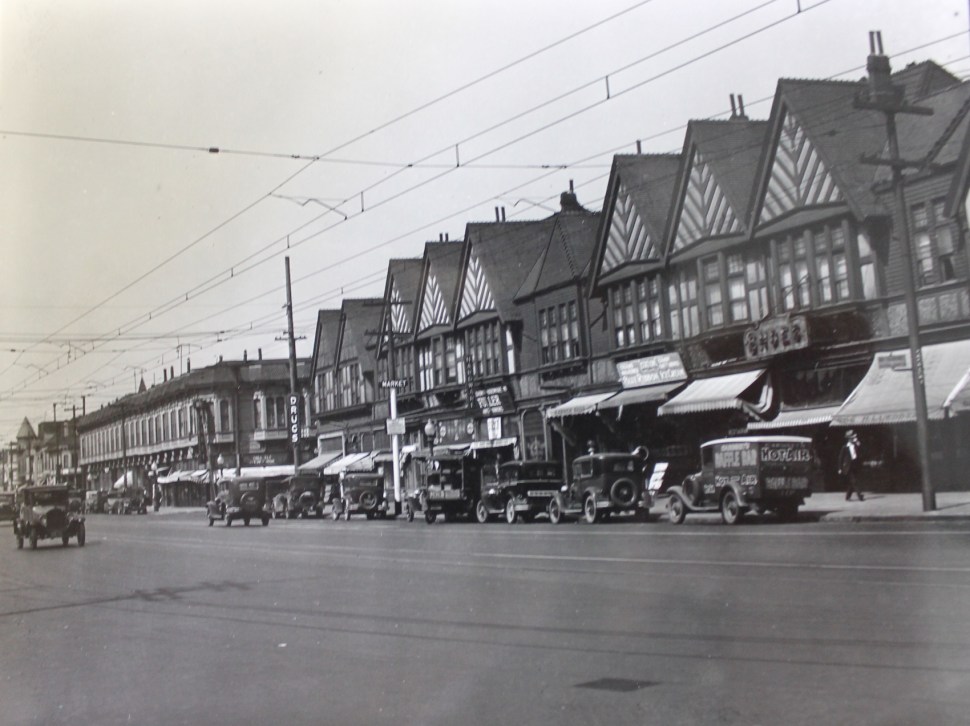
West Oakland’s commercial district in 1940. Photo courtesy of the Oakland Library, Oakland History Room
It wasn’t just the freeway construction. In the 1960s, bulldozers leveled several blocks for a regional post office right on the main drag, 7th Street, while builders constructed BART tracks overhead.
Bowden has no doubt that it was all meant to break up his neighborhood. “It was a lot of construction,” he said. “A lot of dust. A lot of friends relocated.”
Though the California legislature had defined the route of what would become I-980 in 1947, no one tried to build it until the 1960s, and by that time, things were starting to change. The Civil Rights Movement was gaining traction, the courts were ruling that segregation could no longer be government policy, and the Black Panther Party was rising up in West Oakland. The freeway would no longer divide white and black residents because black people had already moved into the rest of Oakland at that point. Still, the logic of bureaucracy pushed the freeway into being.
“It was conceived at a time when freeways were gutting communities by design,” Nichols said. “But somehow it stayed on the books long enough that it just made it to the front of the line.”
Construction started in 1962, and soon bulldozers began clearing a path through Oakland. Demolition crews knocked down houses, setting off protests, but there wasn’t much activists could do: The highway builders seemed to have the law on their side.
But in the mid-1960s, the federal government began pouring money into legal services for low-income communities as part of President Lyndon Johnson’s War on Poverty. In 1972, a young lawyer named Stephen Berzon, funded by Johnson’s Legal Services Program, came up with an idea for a lawsuit. It wasn’t enough to relocate people, he argued, the California Department of Transportation also needed to replace the housing it tore down.
A federal judge agreed with Berzon and gave him an injunction, stopping the earth movers. The project sat in limbo for years, with the construction site acting as a parking lot for heavy equipment.
People from the neighborhood told Berzon they didn’t necessarily want to stop the freeway; they just wanted decent homes. A freeway would be better than what the earth movers left behind, a muddy gulch running through the center of Oakland.
“I don’t know what the community wanted prior to the freeway construction beginning,” Berzon said. “This was the era of highway revolts, where people in San Francisco stopped the freeways planned to run through the city. But that feeling had not been expressed in West Oakland. Housing, that’s what the fight was about, and it succeeded.”
In 1973, Roger Clay, Jr., a young attorney living in West Oakland, began working with Berzon. It was Clay’s first case out of law school, and when Berzon moved to Washington, D.C., in 1974, he took over. For more than a decade, he worked to make sure that the government built new housing and honored the city’s promises to keep his clients’ rents low.
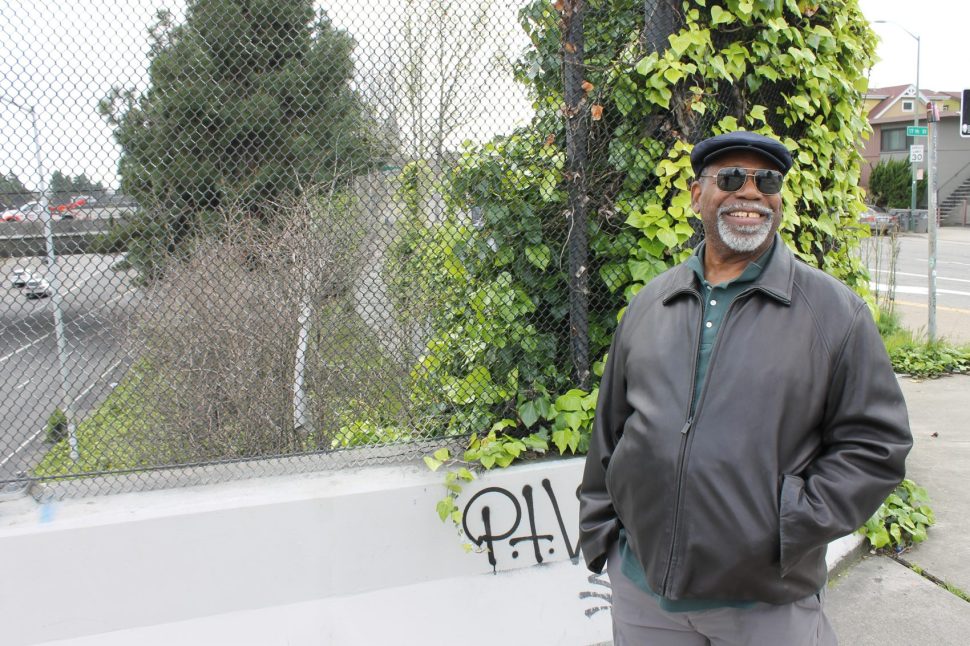
Roger Clay, Jr., on a 980 overpass that his clients helped to design. Photo by Nathanael Johnson
Clay recently took me on a driving tour of the area to point out the way residents had shaped the I-980 project. His clients wanted the freeway to run through a hollow beneath the streets — not over an elevated structure as planned — so that it wouldn’t form as much of a barrier and that the earthen sidewalls would contain some of the noise and pollution. (As a result, I-980 today is like a hilly Hot Wheels track: If you drive its full two miles from north to south you start on the elevated section, built before the lawsuit, then swoop down below grade, before rising again to connect with Interstate 880, another raised freeway.)
Clay’s clients wanted the houses in the freeway’s path moved to empty lots, and they got their wish. He also got the transportation department to pick up and reposition a house that had already been moved. “They had this house facing the other way. So we fought, and I got them to turn it around,” he said. He pointed it out as we drove by: “You can see: It looks good.”
Had he won every fight? I asked.
“Yeah, we did.” Clay shrugged. “I mean, when you have leverage …”
He had leverage because Oakland’s city leaders had decided they needed that freeway. Cities were losing people and their tax revenue in the 1970s, and Oakland thought it could stem the tide with a massive downtown redevelopment. It drew up plans for a downtown shopping center with freeway off ramps running directly to its garage, so that suburbanites could do their shopping without ever setting foot on Oakland’s streets. But this downtown plan depended upon finishing the freeway, and the fastest way to do that was to say “yes” to all of Clay’s demands. (In the end, the plans for the shopping center fell apart and it was never built.)
This wasn’t mere expediency. City leaders had a genuine desire to improve West Oakland, Clay said. By 1977, West Oakland community groups, the Black Panthers, Oakland’s first black redevelopment director, John B. Williams, its first black mayor, Lionel Wilson, and the local Chamber of Commerce were all lobbying to finish the freeway.
By the end of the decade, everyone was singing from the same hymnal. Clay’s clients were happy with the deal he’d negotiated and ready to move forward. The Sierra Club wanted to file a lawsuit against the freeway, but backed off after talking with Clay. “They really were chomping at the bit,” Clay remembered. “We said, ‘No, our clients want it built, they just want housing built, too.’”
Some of the West Oaklanders I talked to about the possibility of I-980’s removal, like Bowden, had a well-earned cynicism about the prospect of another big government project. Bowden has lost faith in the possibility of politics serving him: “Like I said before: Politricks. It’s in existence today more than ever.”
Clay doesn’t share this cynicism. He’s seen first hand how community groups can shape a big infrastructure project to their desires. But because his clients wanted I-980, he bristles at the argument — advanced by activists and some long-time residents like Bowden — that the highway was an act of violence against West Oakland. “The people were involved in creating this, and now you are saying it was imposed on them,” Clay shook his head, clearly annoyed.
“It’s not that I’m against change, it’s the attitude of people coming in and saying, ‘That’s not good,’” he said. “Well, people thought it was good, and people were happy with it.”
Nichols, Oakland’s now-former transportation director (he retired earlier this year), had no doubt that Clay negotiated a good deal for his clients under the circumstances, but he has a problem with those circumstances. This freeway, he told me, was flawed from the start. First planned as a “racist moat-building exercise,” then as a connection to a never-constructed bridge to San Francisco, and finally as a driveway to a shopping center that was also never built, it now carries less traffic than some of Oakland’s surface streets. To him, its existence seems ludicrous. “Why, why did anyone build that?” he said.
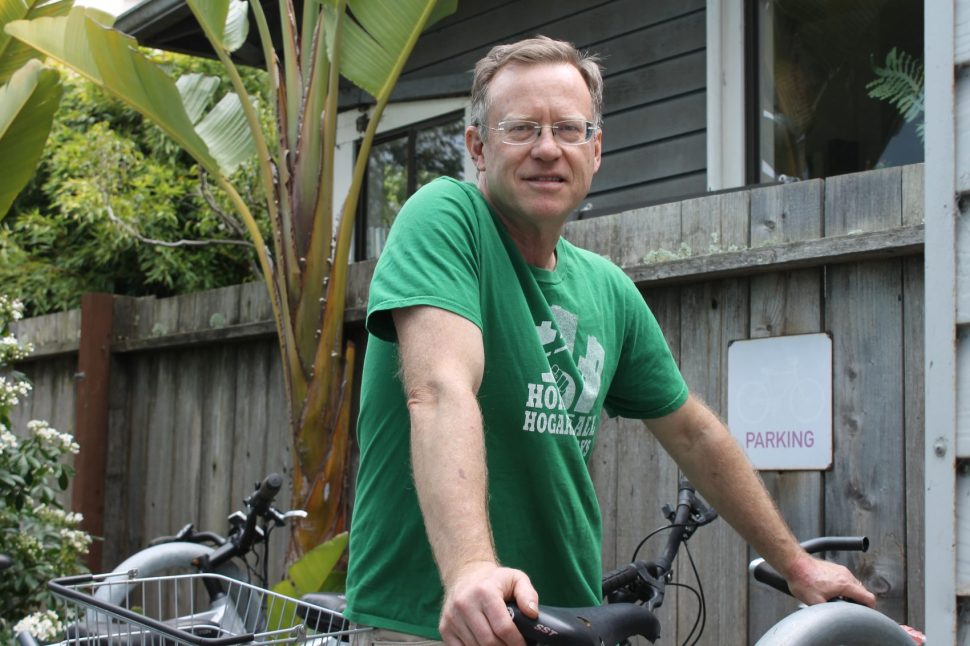
Matt Nichols. Photo by Nathanael Johnson
Even so, Nichols understands why people are wary of removing the freeway but he thinks it’s worth doing the studies to find out if it could work. “Is it going to be worth the money? Are we crazy?” he said. “Those are fair questions.”
Some of the people who initially balk at the idea of tearing up the freeway become more interested after they consider what could replace it, Nichols said. Over the past few years, Oakland’s city government has been holding meetings on the future of the 980 corridor to capture what residents want. Sensenig, and another member of ConnectOakland, Jonathan Fearn, said residents have turned up at the meetings with lots of ideas for better uses of the land, like bus lanes, parks, and affordable housing. Fearn sees the response as an encouraging sign: People in the community may embrace the idea of replacing the freeway, if they get to choose what comes next.
“What may have been a good thing in the ’70s may need to be rethought 50 years later,” Fearn said. “Back then they didn’t think about sustainability, and they didn’t think about climate change. We are at this critical time when we need to rethink our fundamental choices.”
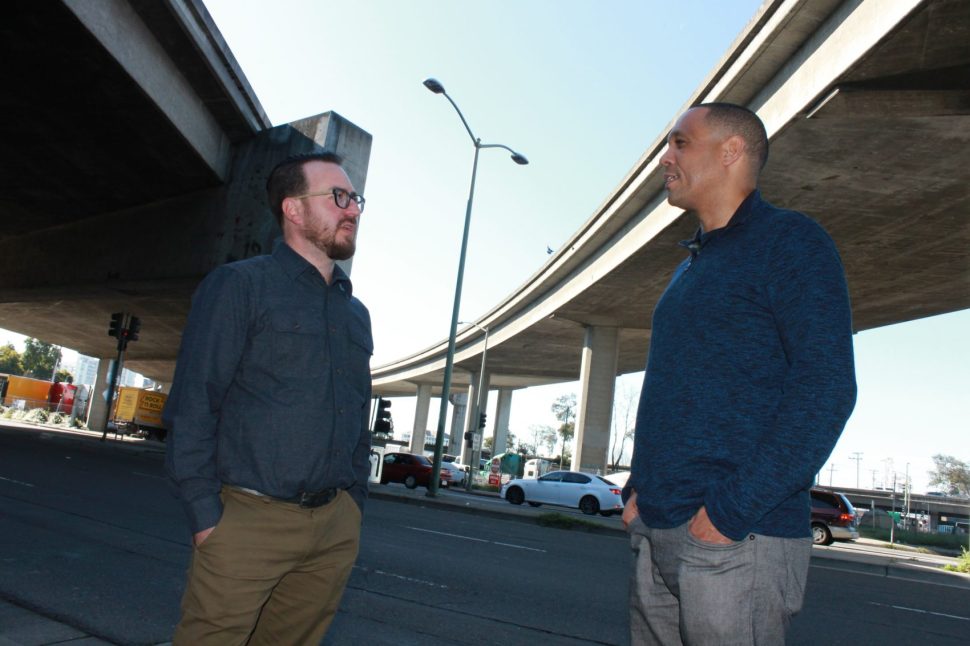
Chris Sensenig and Jonathan Fearn of ConnectOakland beneath I-980 where it connects to I-880. Photo by Nathanael Johnson
The obvious question is: How do you pay for a freeway-to-flowers project that could easily run into the billions? Oakland’s city government could recoup money by selling some of the land for office towers and market-rate housing. In fact, in the latest draft of its downtown plan, there’s an illustration of a layout yielding nearly 5,000 units of housing and 1.5 million square feet for stores, offices, and restaurants where I-980 currently sits. Selling some of land dedicated to cars, in other words, could provide the cash to house people who might otherwise be pushed out.
Because this neighborhood would start as a blank slate, it wouldn’t cost much to put in green infrastructure. Pipes to channel water from shower drains into irrigation systems, a micro-grid for renewable electricity, and shared heating and cooling systems could make economic sense, Nichols said.
These eco-friendly neighborhoods that urban designers imagine will replace freeways aren’t always so appealing to residents. In New Orleans, for instance, the city was seriously considering tearing down its Claiborne Expressway, which runs through the historic Tremé neighborhood, until many locals pushed to keep it, fearing the teardown would drive up housing prices and drive out the current residents.
It’s a different story in Portland, Oregon. Aaron Brown is a campaigner working to stop the expansion of Interstate 5 through a historically black, but gentrifying neighborhood. When he first started talking about it at neighborhood meetings in 2017, he received a less-than-welcome reception.
“Mostly it was old people using the opportunity to shout at me about the bike-share bikes all over the place,” he said. Brown kept at it. He contacted community members on social media. He went to countless meetings with parents and teachers at a middle school next to the proposed expansion. Then he shut up and listened, searching for common ground.
Parents from the middle school’s PTSA recently filled a public hearing to testify against the freeway. Brown was elated. “If we can stall this project two to four years and get another couple awesome, radical people on the city council, and if people start waking up to the danger of climate change, maybe we could remove this freeway entirely,” he said.
Brown would be happy with stopping the freeway’s expansion; scrapping the entire thing is a distant dream. It would be a lot harder to remove a section of I-5 — the primary freeway along the West Coast — than I-980, which is just a two-mile long shortcut between other freeways. But even that simple trim would be a tough slog if the supposed beneficiaries in West Oakland end up opposing it.
What, realistically, will happen to I-980? ConnectOakland provided a vision. Mayor Schaaf provided the official sanction for ripping it out. Next, Oakland will need engineers to figure out what different options would cost and facilitators to organize more conversations with residents about the best use of this land. Oakland’s city government won’t do that itself, Nichols said: The staff is stretched thin just trying to pave pothole-ridden streets. But he thinks the organization that plans new transit lines — the Metropolitan Transportation Commission — has the bandwidth to move the project forward.
The I-980 teardown could become part of a regional push to relieve traffic congestion by building a second subway tunnel to San Francisco beneath the bay. The underwater tube trains currently traverse is like a two-lane road — with one lane seemingly always being repaired. The trains are crowded with passengers, and the bridges overhead are even more crowded with cars. The system, according to a government study, is “bursting at the seams,” and almost certainly requires another crossing.
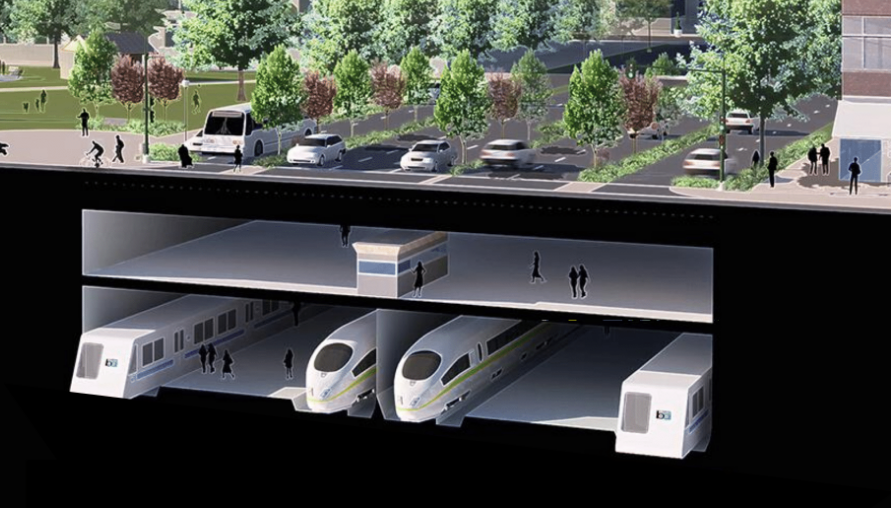
A rendering of how transit might run in the space currently dedicated to cars. Rendering by Groundworks Office, ConnectOAKLAND
Because Oakland has said it would prefer a new BART line running down the land occupied by I-980, there’s a good chance that the vision for freeway removal will be carried along by the larger effort to build new rails, just as the vision for building it was buoyed by plans to construct a massive downtown shopping center.
The idea of removing freeways excites activists because it promises to reduce emissions and air pollution while making cities more pleasant and functional. It also has the potential to undo some of the damage inflicted by the racist, fossil-fueled policies of the past — exchanging sprawl for bustling cities, trading cars for transit. But those relics may remain unless those who live in their path believe they’ll benefit from their absence.

